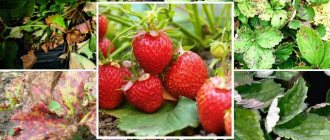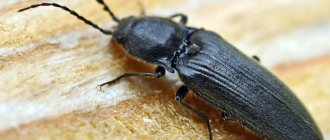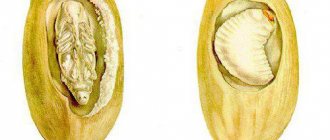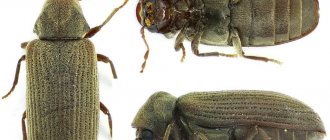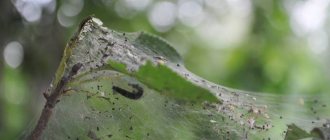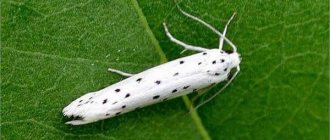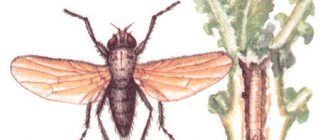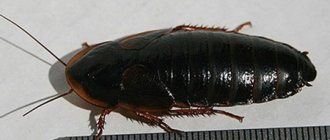What does a bark beetle look like?
The appearance of the bark beetle is quite specific; it is almost impossible to confuse the insect with another garden pest.
The bark beetle is a small insect, the length of its brown body reaches 5-6 cm. The body is cylindrical, with short hairs located on the surface of the body of adult individuals. A distinctive feature of the bark beetle is the presence on the back of the body of a peculiar bevel, surrounded by small teeth. This “device” is necessary for the insect to remove the remains of the bark that have not been digested by the esophagus.
The insect has an excellent sense of smell. In flight, the bark beetle is able to determine the most “delicious” tree for it and fly to it. More often, fruit trees, such as apple trees, become the “target” of the pest. The female bark beetle lays larvae in the bark of trees. Penetrating inside the trunk, the insect makes long and winding passages, choosing the most convenient place for future laying. The larvae hatched from eggs are very voracious; their food is tree sap and tissue.
Bark beetles are capable of attacking a large area of the garden. They, emerging from the bark of the affected tree, can fly to other fruit plants, also causing them significant harm. During the spring-summer season, 2-3 generations of bark beetles can be born, and each of them becomes a dangerous enemy for fruit trees.
Features of the bark beetle
The bark beetle was named so because it spends a significant part of its life under the bark. The males of such beetles have a concave head, while the females have a sharply convex head. On the predorsum of beetles there are tubercles and denticles. The elongated quadrangular back of the beetle is almost spherical. Scales or stripes are densely located on the surface of the elytra. In adult beetles, the body is brown and the head is almost black. The worm-like, legless bark beetle larva has a whitish color. Some species live mainly in cut trees, while other species prefer to live only on living plants. However, there are also species that are able to live either on a cut tree or on a living tree.
In a tree, each type of such beetle makes tunnels of a certain shape, from which it is possible to find out which bark beetles have settled on the plant. Females gnaw through the bark and make passages in the tissues of the tree in which they lay eggs. After some time, larvae emerge from the eggs and feed on both plant tissue and its sap, this leads to the destruction of the tree from the inside. The grown larvae pupate and spend the winter inside the plant. And with the onset of spring, adult individuals fly out and try to find a mate.
Stimulation of apple tree immunity to protect against bark beetle
Weakened apple trees suffer from the bark beetle. The wood of a healthy tree is strong, making it more difficult for beetles to survive and reproduce there. Measures that increase the protective powers of apple trees are carried out to prevent the pest.
Activate the immune system, improve the quality of photosynthesis with the help of “HB-101”. Stages of preventive measures:
- In the spring, seed granules around the perimeter of the tree trunk;
- after flowering, spray the crown 3 times with a solution (1 ml of product per 10 liters of water), an interval of 7 days.
Using the “Rich-Micro” fertilizer, tissues are saturated with microelements. Fertilizing increases resistance to infections and pests. Apply “Rich-Micro Copper + Zinc + microelements”. When preparing a solution, dissolve 1 tbsp in 10 liters of water. l. fertilizers The treatment is carried out per sheet 4 times with an interval of 7 days.
To increase stress resistance, apple trees are watered with Gumi-30 Universal solution once every 2 weeks. Paste (100 g) is diluted in water (200 ml). The concentrate is used to prepare a working solution. For 10 liters of water add 1 tbsp. l.
It is difficult to save a tree affected by bark beetle. Planned preventive treatments of the garden with modern preparations are the best option for combating the beetle.
BI-58 New
An improved version of the insecticide BI-58 to combat beetles that feed on plants. The action is based on the substance dimethoate. After coating, the product is absorbed into the bark and penetrates into the deeper layers. Insects eat them, are poisoned and die, BI-58 paralyzes the nervous system. The new composition of the drug lasts longer, and its effectiveness does not depend on weather conditions.
Fruit trees that are traditionally grown in Russia are resistant to the effects (apple, pear, plum trees), and are suitable for shrubs (currants, raspberries, gooseberries). Also used for gardening, indoor plants, and in greenhouses.
- applicable not only for bark beetles, but also for other types of parasites;
- safe for trees;
- acts quickly;
- harmless to people and pets;
- stimulates growth, helps to recover from destruction;
- used simultaneously with other pesticides.
- not suitable for hard water;
- Processing should be carried out during the growing season, at a temperature of at least +12 degrees.
The drugs are produced in capsules, 1 piece per 10 liters of water. The exact dosage is written on the package, depending on the crop being treated. For a garden, 1.6-2 liters of ready-made solution per 1 hectare. Use the solution immediately; storing is not recommended. Use clean water; hardness affects performance. After the start of flowering, the plants are prohibited from being processed; the composition negatively affects future fruits. Cannot be used after the first frost; the likelihood of defeating parasites is reduced several times.
Please note: apply only on the bark, the leaves suffer and die from the substance, follow the dosage.
Buyers recommend it on the positive side, it helps get rid of bark beetles in a short time. It works for a long time, a maximum of 2 applications per season. The smell is specific, unpleasant, the pheromone trap repels parasites. Inexpensive, convenient packaging. It is allowed to mix with fungicides and other insecticides (except for the mixture with AZOFOS). It is not recommended to use it near bees; when spraying, use a respirator and gloves.
Pests of fruit tree trunks. Tree trunk diseases
The following diseases of tree trunks and roots are distinguished: 1) mucilage. 2) thickening, 3) cancer, 4) rot of trunks and roots, 5) death of roots.
Slime leakage is characterized by the leakage of liquid from the trunks of old deciduous trees.
The cause of mucilage is wound damage to trees, frost cracks, bark cracks and others. To treat mucus in trees, it is recommended to cut out the damaged parts and then lubricate these places with coal tar; deep wounds are covered with special putties and cements.
Trunk thickening is a disease characterized by the formation of swellings of various shapes on tree trunks as a result of increased cell growth. The main causes of thickening are fungi, bacteria, mechanical damage and frost damage.
Thickening on cedar and Weymouth pine is caused by rust fungus and is accompanied by tarting. This mushroom is dioecious with a full development cycle. The aecidial stage of the fungus develops on the trunks and branches of these trees and has the appearance of orange bubbles. The mycelium spreads in the tissues of the cortex and causes cell proliferation, as a result of which the affected area thickens.
Control measures. Destruction at a distance of 180-250 m around Weymouth pine and cedar plantings of all types of currants and gooseberries that contribute to the spread of the fungus.
Trunk cancer. The disease is characterized by the formation of a deep wound on the trunk, surrounded by an influx. The cause of cancer in trees is frost damage (frost canker), various fungi (fungal canker), and mechanical damage.
The most dangerous is fungal cancer, caused in most cases by rust or marsupial fungi.
Cancer caused by the fungus occurs on larch and fir trunks. This mushroom belongs to the marsupial fungi, a group of discomycetes.
The development of the fungus in an infected trunk occurs as follows: the mycelium first develops in the phloem, partly intercellularly or in cells and sieve tubes, and kills the bark. Then the mycelium reaches the cambium and kills it, as a result of which the growth of wood in the affected area stops and the wood dies.
Control measures. Trimming dry branches on which this fungus grows as a saprophyte.
On Scots pine trunks, cancer is caused by fungi. The pine disease caused by these rust fungi is of the same nature. Infection occurs through branches, on which the fungus develops primarily and from where the mycelium passes into the trunk. Resin accumulates on the surface of the wound. Every year, the damage covers an increasing part of the trunk circumference and causes weakening of the tree's growth.
Cancer accompanied by tarting (seryanka) is often found on pine trunks. Seryanka is caused by various rust fungi.
Seryanka disease is widespread in pine plantations and is very dangerous for these plantations.
Control measures. Cleaning of trees infected with seryanka in case of mass infection of plantings. Trees must be removed gradually so as not to cause windfall.
Cancer of the trunks of fruit trees and maples is caused by a marsupial fungus.
The fruiting bodies of the fungus are dark red and granular. Infection of trees occurs through wounds in trunks and branches with conidia or ascospores. After the bark falls off, the wood is exposed, forming an open wound. An influx of growing healthy tissue forms around the wound. The tree dies when the wound rings the trunk. The source of infection is the fruiting bodies that form around the influx.
Control measures. Trimming branches infected with the fungus and cutting down heavily infected trees.
On the trunks of poplars and willows, cancer is caused by a marsupial fungus from the pyrenomycetes group.
The fruiting bodies are flat or lenticular, black. The fungus infects trees through wounds on trunks and through dead branches, and mainly affects weakened trees.
Control measures. Trimming infected branches and smearing cancerous tumors with carbolineum.
How to get rid of bark beetle
There are various methods of control, depending on where the beetle has settled - on a tree or in a house. If a beetle is found in the garden, it means it is already in the house. Therefore, the approach must be comprehensive: the beetle must be destroyed both in the garden and in the house.
How to get rid of in a tree
Methods of combating beetles on trees can also be different: it can be destroyed mechanically or using a special solution. For example:
- Using steel wire. You need to arm yourself with a long piece of thin steel wire and use it to examine all the passages. After this, the tree is treated with insecticides. The method is quite time-consuming, but effective, especially when beetles emerge from under the bark, during the flowering period and throughout the summer.
- Treatment with a special solution. Before this procedure, you need to remove those areas or branches that have already been destroyed by the bark beetle. To prepare an effective solution, you need to take 6 parts of paraffin, 3 parts of rosin, then melt them and bring to a boil. As soon as the composition boils, add 10 parts of vegetable oil to it and bring to a boil again. The solution is boiled for about 10 minutes. You can add a little fungicide to the composition. All trees in the garden are treated with this product. It is better to burn those beetles that were able to crawl out, as well as the affected parts of the trees.
How to fight in the house
To kill a beetle in your home, you can use a number of methods. For example:
- Treat the wood with protective agents such as “Anti-bug” or “Antishashelin”. Any of these remedies is quite dangerous for the bark beetle and its larvae.
- It is permissible to treat wooden structures with diesel fuel, kerosene or grease, as our grandfathers did.
- Insecticides can be pumped into the pest's tunnels using a syringe.
- Some insecticides are available in the form of aerosols, which simplifies their use.
How to get rid of shashel, simple and free. New method!!!
Watch this video on YouTube
Temperature control method
A fairly effective method of control, but the beetle tolerates sub-zero temperatures down to -30 degrees without problems. But if you use liquid nitrogen, it will make the wood unsuitable for consumption and life. High temperature conditions, when wood heats up to +65 degrees, have a negative effect on the pest. Naturally, it is unrealistic to warm a house or building to such a temperature. But this method can be used in the production of wood products.
Pheromone traps
This method is effective when dealing with adults. A special substance collects beetles in one place, after which they are easy to destroy. This method is effective in any conditions, but has a number of disadvantages. The disadvantages include:
- Such substances attract only adult individuals, but they have no effect on larvae.
- Beetles located in the neighboring area will be able to react to such substances.
In fact, pheromone traps are a reliable and effective way to get rid of bark beetles. If you destroy adult individuals, then there will be no one to lay eggs and the reproduction of the beetle can be stopped altogether.
Life cycle of the bark beetle
At the end of September - October, when the air temperature drops to +5 degrees, the bark beetle hibernates in a pre-selected place, which allows it not to freeze throughout the winter. The roots and bark of trees, dead wood and dead wood, and forest litter are well suited for this. With the onset of spring, as soon as the sun warms up the wintering site, the surviving beetles emerge from hibernation and begin searching for a new tree to reproduce. An adult can tolerate frosts down to -30 degrees; larvae and pupae die at -13 and -17 degrees, respectively. Therefore, the bark beetle’s particularly active flight in April–May occurs after mild winters.
It is recommended to carry out primary treatment of trees no later than April 20 to prevent the infestation of bark beetles
To breed offspring, the bark beetle selects a weakened tree with thick bark; in the absence of such, it selects any healthy, young tree, or even a stump. Also, the choice of a bark beetle may fall on a healthy tree or shoots, if all the available trees suitable for reproduction are already occupied by its relatives. Having looked for a suitable place, the bark beetle gnaws a hole in the bark measuring 2-3 mm, then attracts several females with a specific pheromone to breed offspring and after some time leaves the tree to search for the next one. After 60-70 days from the moment of settlement, a new generation of the bark beetle grows up and begins its own adult life, and already from the beginning of July the second, summer flight of the bark beetle starts. Each adult can produce from 2 to 4 offspring per season, each of which completely destroys the coniferous tree.
It is recommended to carry out preventive barrier treatment of trees 3-4 times per season, depending on the intensity of the bark beetle’s flight:
- primary processing: from April 10 to April 25
- repeated treatment (during intensive flight): from May 15 to May 30
- secondary processing: from June 15 to June 25
- repeated treatment (during intensive flight): from July 15 to July 25
Signs of a tree affected by a pest
The bark beetle is small in size - no more than 6 mm in length. It has a brown, cylindrical body, covered with small hairs, and has an excellent sense of smell, which helps almost instantly find the wood necessary for its nutrition and reproduction. In it, it gnaws long passages, severely damaging trees.
There are several varieties of bark beetle:
Wrinkled sapwood. This beetle is quite small in size - only about 3-4 mm. It has a black head and brown wing flaps. He loves trees that produce fruits with seeds, but sometimes he can enjoy rowan berries, dogwoods, etc. Its larvae make up to 30 moves under the tree bark. Most often, either the trunks of young trees or medium-sized branches of mature trees are affected.
Fruit sapwood. This beetle is also quite small in size - no more than 4 mm. It has a black body that shines. Fruit sapwood prefers fruit trees to all others. This beetle begins to search for “prey” with the beginning of flowering of fruit trees and feeds on trees until the month of August. The beetle larvae are capable of making passages up to 5 cm long and up to 2-3 mm wide in the bark of a tree.
Western gypsy bark beetle. This species of bark beetle most often lives in the bark of deciduous trees. It is worth saying that sapwood prefers diseased or damaged trees, but the western gypsy beetle will prefer a healthy tree to a diseased tree. And this is understandable: after all, its larvae do not make passages, unlike other bark beetles: the female bark beetle gnaws the passages, secreting juice, and the larvae eat the mycelium of the fungus, which appears in the place where the female’s juice remains.
In order not to do extra work and not disturb the tree again, you need to know for sure that it is affected by the bark beetle. Let's look at the main signs that indicate that this pest has settled in the tree:
- In close proximity to the tree, yellow/brown dust appears on the ground, which the bark beetle throws out in the process of creating its burrows in the tree bark. In addition, the dust may attract other bark beetles.
- Woodpeckers appear on the trees - they feed on bark beetles.
- Over time, small holes (flight holes) appear on the trunk of trees. Sometimes resin leaks out of them.
- Drawings of various shapes appeared under the tree bark - a sure sign that a female bark beetle was operating there and had already laid eggs.
It should be borne in mind that bark beetles are quite insidious pests, since, despite their special taste preferences, they can also infect trees that are simply located next to their “favorite” delicacy.
An adult beetle is a small insect, only up to 4 mm long, with a cylindrical body covered with hairs. Its main color is dark brown, its legs and antennae are dark brown, and its entire body is covered with dotted stripes.
In the spring, when apple and pear trees are about to finish flowering, these insects begin to fly out. For several weeks they mate, fly away in search of new homes, and lay many eggs under the bark of trees.
After some time, larvae hatch from the eggs - small white worms that have no eyes, no legs, but have powerful jaws with which they gnaw on wood. Until next spring, for almost a whole year, the larvae feed on the sap and soft tissue of the tree. In the spring, the larva develops into a beetle and emerges to increase and spread the population.
When to take action
To get rid of the pest, you must first of all promptly detect that bark beetles exist and have already begun to destroy the garden. To do this, you need to regularly carefully inspect tree trunks and observe the insects that you encounter on the site. Many sources provide colorful descriptions of beetles with detailed images of wings, coloring and other anatomical details. However, you need to understand that there are more than 750 species. And each of them can harm garden crops.
For example, gardens in the mountains are most often attacked by the palm beetle. Given their proximity to coniferous forests - typography. In the European part of Russia, these are usually pests of fruit and berry plantings - gypsy, apple and wrinkled species. There are enough differences in their appearance that it is not always possible to guess the bark beetle in each of them.
What do all these beetles have in common:
- small size (8-15 mm);
- dark brown or black rounded back;
- sloping rear part of the body, covered with small teeth.
But there are much more obvious signs indicating that the garden is affected by the bark beetle and it’s time to get rid of it:
- suddenly a woodpecker has settled in the garden and is knocking on the same tree - most likely, it is this tree that is infected;
- the presence of small holes in the bark - round and oblong;
- stains of resin appear on coniferous trees, gum stains on fruit trees;
- small sawdust under the tree.
You should especially carefully look at the wood flour that pours out of the holes. If it is brownish in color, this means that the beetles are still only occupied with the bark. Therefore, you can get rid of them and save the tree. If the sawdust is white, it has penetrated much deeper and has probably damaged the vital functions of a living plant organism and thereby doomed it to inevitable death. Experienced gardeners and professional pest controllers say that in this case, even the most powerful chemicals do not work.
Methods of controlling bark beetle
At the moment, there are various ways to combat the pest, as well as means of protection. Therefore, we will highlight only the most effective ones.
What will help defeat the bark beetle:
- preparations based on chemical components;
- various traps and repellers;
- injection of trunks.
All methods are good, but they should only be used at a certain stage. Therefore, let's take a closer look at each of the techniques.
Preparations based on chemical components
Chemicals, in other words, insecticides, are distinguished by their ability to penetrate into the deepest layers of the crop. Therefore, most often in the fight against bark beetles they resort to these substances. But at the same time, such processing can be performed only after flowering.
It is worth noting that experienced summer residents recommend using the following means:
- Confidor;
- Calypso;
- Arrivo;
- Pirinex.
Important! Insecticides should be applied only after flowering has ended. As a rule, it is during this period that the main years of these individuals begin.
Therefore, before starting treatment, you can put on a protective suit or protect your skin in another convenient way.
As for the processing method, first you will need to dilute any of the above products and use them strictly according to the instructions. You need to spray the bark with insecticides starting from the branches, and then the trunk of crops such as pear, apple, and all neighboring trees. Then, after two weeks, spraying must be repeated.
Traps and repellers
One of the methods of protection against bark beetle attacks is to catch parasites. It is performed during the summer of the insect. And to catch beetles, experienced gardeners advise making traps from wood.
When beetles are looking for a new home, they rely specifically on their sense of smell. And the smell of cut wood strongly attracts them, and they begin to plant themselves not on living crops, but on cut fragments. Well, when the summer period ends, the wood inhabited by new residents must be collected and destroyed by burning.
In addition to tree traps, you can drive the beetle out of the garden using so-called antipheromone repellers. This product is sold in the form of tablets, which have a disgusting odor to the bark beetle's sense of smell.
If you decide to use this particular method, then you need to purchase and distribute the tablets at least a week before the start of the insect’s flight.
Today there are so-called pheromone traps, but they are intended for gardens with an area of at least 5 hectares. Well, as for private front gardens, such funds will be of no use.
The main advantage of all the above-described means is that they are completely harmless to the environment and to human health. But they need to be used only before the start of summer. Otherwise there will be no positive result.
Injection of the barrel
Spraying with insecticides, using traps - all this is effective only if the bark beetle has not yet penetrated deep into the wood of the tree. But if the individual managed to infiltrate, then it can only be overcome by injecting the barrel part.
This technique is very effective and efficient. Moreover, sometimes it is possible to save a tree trunk only by using injection.
This manipulation is performed by inserting it into holes made by the bark beetle. As a rule, the following drugs are used for such purposes:
- Confidor;
- Tanrek.
If you plan to syringe, then you need to dilute the drugs so that the solution is highly concentrated. Well, after you carry out this manipulation, do not forget to lubricate the trunks with lard or margarine, with the help of which the bark beetle larvae are completely destroyed. And do not forget to regularly inspect the plant during this period.
Traditional methods
There are a lot of folk methods, but we will consider only one recipe that can really be used, since it helps cope well with beetles. So, to treat a tree immediately after flowering, you will need to stock up on the following products:
- 6 liters of warm, settled water;
- 2.5 cups of laundry soap, pre-grated on a fine grater;
- 2.5 cups of carbolic acid.
All components are thoroughly dissolved in warm water, then the prepared solution is diluted in 15 liters of water, and the crop is thoroughly sprayed with the prepared product. After a week, the treatment must be repeated. Because there may still be parasites on the crop that survived the first treatment.
Drugs used
"Clipper" ("Tolstar", "aktara")
“Clipper” (“Tolstar”, “Aktara”) (the most effective means for combating bark beetle)
Preparations of universal action, destroy bark beetles and other pests and insects. According to the mechanism of action, “Clipper” is a contact-intestinal insecto-acaricide. It will completely disintegrate in 4 weeks, after which it is necessary to re-treat. Insecticides are safe for humans, animals and plants!
Directions for use: treatment of tree trunks a week before the bark beetle begins to emerge.
Dosage: 150ml/10l of water, Consumption rate 150-200ml per tree.
Price: Canister 5 l – 22000 rub.
"Ram"
“Taran” (a product for combating bark beetles, ticks, bedbugs and mosquitoes)
A drug similar in properties to the drug “Clipper”. Destroys almost all gnawing and sucking insects, very effective in the fight against ticks. Typically a mixture of Clipper and Ram is used in a 50/50 ratio.
Directions for use: treatment of tree trunks a week before the bark beetle begins to emerge. Treating the area against ticks, mosquitoes and pests.
Dosage: 50ml/10l of water, Consumption rate 50-100 ml per tree.
Price: 5l canister – 18,000 rub.
Cartocide (broad-acting antiseptic)
A product for combating fungal, viral and bacterial diseases of trees. Stimulator and accelerator of growth of coniferous trees and ornamental and garden trees and shrubs. Has antiseptic and bactericidal properties. Protects trees from moss and lichens. Using Kartotsisch together with insecticides increases their effectiveness. Insects do not become accustomed to the drug. The product is resistant to leaching and ultraviolet radiation; one treatment of trees at the beginning of the season is sufficient. The drug is safe for humans, animals and plants!
Method of application: treatment of tree trunks against fungal and bacterial diseases. Used in solution with the preparations “Clipper” and “Taran”.
Dosage: 50ml/10l of water, Consumption rate 50-100 ml per tree.
Price: 5l canister – 13,000 rub.
Bi-58 (now almost never used)
Destroys all insects and pests indiscriminately, both harmful and beneficial. It disintegrates slowly - 2-4 months and is used only at the beginning of the season. And does not require additional processing. Does not respond to temperature fluctuations, rain and ultraviolet radiation. The insecticide is highly toxic and is not recommended for use near residential buildings!
Directions for use: treatment of tree trunks a week before the bark beetle begins to emerge.
Dosage: 100ml/10l of water, consumption rate 100-150 ml per tree.
Price: 5l canister – 9,000 rub.
Senezh-Insa - a bark beetle remedy with a stable effect
An example of an excellent antiseptic is SenezhInsa, also made in Russia. The drug has been actively used since 2012 and is in demand both among professional agronomists and amateur summer residents. The product is completely colorless, packaged in small canisters of 5 liters or large barrels of 60 kg.
The concentrate is based on water, so when interacting with wood, its texture and color do not change.
The drug penetrates the tree bark, leaving the active components there. Non-toxic and effective. Helps get rid of different types of beetles and bacteria, regardless of the stages of their development.
Summarizing all of the above, we note that it is not enough to know how to cure a tree from bark beetle when insect damage has reached such a level that it is almost impossible to save the plant. In order for the garden to grow healthy and fruitful, you need to monitor the trees, preventing the appearance of pests and treating the trunks at the initial stages of infection.
Fruit trees are often affected by pests, as a result of which gardeners do not receive enough harvest, and the plants often die. Thus, the bark beetle on an apple tree often causes its loss, and in the absence of timely measures taken, the brown sapwood beetle with a striped chitinous shell can destroy the entire orchard.
How to deal with bark beetle on an apple tree - advice from gardeners
Signs of defeat
The first signs of a bark beetle attack are the appearance of wood flour and sawdust on the bark of a tree or near the trunk. The sawdust is pushed out by beetles and their larvae, gnawing out the wood of the fruit tree. When examining the bark, you may notice small holes from which dust spills out.
The color of the sawdust indicates the degree of damage to the tree:
- brown and brown sawdust shows that the bark beetle is gnawing on the bast - the outer membranes of the trunk;
- white sawdust is an indicator of deep damage to the trunk by the pest.
Associated signs of damage:
- Frequent visits to trees by woodpeckers. This bird usually feeds on pests that live inside the wood.
- Sudden drying of branches, wilting, stopping of shoots in growth.
- Holes in the bark about 2 millimeters in size and gum production are obvious symptoms of bark beetle activity.
- Peeling of the bark, exposure of wood, corroded by winding passages, is the last stage, which usually ends with the death of the tree.
Experienced gardeners believe that there is no point in treating a tree heavily damaged by bark beetles - it must be immediately destroyed.
We help develop immunity in the culture
The best and most effective way to protect trees is to develop immunity in them
It is important to understand that a healthy crop will have strong wood, due to which the bark beetle will avoid such a crop. After all, he is looking for a tree with soft wood, in which it is easier for him to survive and lay his own offspring
And to boost and strengthen your immune system, use tools such as:
- use the preparation nb 10, the granules of which are scattered around the tree and then watered with water;
- gum 30;
- phosphorus and potassium agents.
All these substances can strengthen the immune system of the apple crop and make it unstable to external negative factors.
Ways to combat bark beetle
If a tree pest parasitizing fruit trees is detected, measures to combat it must be taken immediately. The absence of protective measures will allow insects to completely destroy garden plantings. There are several ways to deal with bark beetle on fruit trees. Modern developments in the chemical and agricultural industries make it possible to prevent the appearance of a plant pest and prevent the proliferation of a colony of this beetle.
Getting rid of bark beetles using chemicals
Plantings can be treated for the purpose of prevention and control of infested parasites using broad-spectrum insecticides:
- “Confidor Extra” is a non-toxic drug for people and animals against many garden pests, which has a long-term systemic effect;
- “Aktara” is a Swiss product that has a contact-intestinal effect on garden parasitic insects;
- "Calypso" is an insecticide that has a pronounced enteric-contact effect, preventing the appearance and reproduction of parasitic insects;
- “Antishashelin” is a drug that promotes the death of pests of trees, forests, and their larvae.
It is necessary to treat fruit tree plantings immediately after flowering, when harmful insects begin the process of swarming and searching for a suitable plant object. After 14 days, the procedure is repeated. For maximum effectiveness of the drugs, the entire crown area must be treated. It is advisable to carry out processing using protective equipment. There are other ways to destroy the bark beetle on an apple tree.
Immediately after flowering, it is necessary to treat fruit tree plantings
Gardeners use different methods to combat bark beetles on apple trees. It is difficult to save beetle-infested trees. The measures are effective at the initial stage. Advanced stages cannot be treated. Apple trees eaten by the beetle are destroyed. To protect the garden from pests, they resort to folk recipes and chemicals.
Prevention of tree infestation
- Installation of pheromone traps along the boundaries of the site. This will make it possible to detect the presence of the bark beetle at an early stage and take preventive measures to combat it: treating spruce and pine trees with insecticides, monitoring and timely removal of infected trees. This is only a preventative measure and does not guarantee that the trees will not be infected.
- Treatment of healthy trees against bark beetle during the flight of the bark beetle. The bark beetle is not active all year round. In the spring, at the end of April, the bark beetle wakes up from hibernation and flies to living trees to reproduce. In June, the second generation of bark beetle hatches and more and more trees become infected. There can be up to four such flights over the summer! At the end of September, the bark beetle reduces activity and looks for places to winter.
- Removal of infected and dead trees and destruction of infected logging residues. The bark beetle can live for a long time in dead and fallen trees. And under favorable conditions, it can fly out and colonize healthy trees on the site.
- Timely sanitary pruning of trees. Pruning dry branches on spruce and pine trees significantly increases the resistance of a tree infected with diseases, rots and parasites, which increases the tree's immunity.
- Stimulation of the crown and root system of the tree. Feeding trees and treating trees against parasites and diseases, as well as stimulating growth, also increases the resistance of spruce and pine trees to bark beetles.
If the tree is already infested, then it will no longer be possible to save it, and in order to save the rest of the trees on the site, it must be removed as quickly as possible, and the logging residues removed or burned!
The bark beetle is an uninvited guest in the garden and on the site
The bark beetle is the most dangerous insect that infects and destroys various types of wood and trees. Both coniferous and deciduous trees, as well as fruiting representatives of the garden, can be attacked. You will learn more about how to get rid of the bark beetle on fruit trees, about the methods and methods of exterminating this harmful insect in this article.
Fighting bark beetles in the garden is not an easy task. In order to completely destroy it, an integrated approach is needed. To do this, you will need to carry out timely spraying and fumigation not only of the trees growing on the site, but also of wooden buildings located nearby.
The fight against bark beetle on an apple tree involves the use of minimally toxic means, since chemicals designed to destroy the beetle can get on the fruit, which is extremely dangerous for human consumption. Therefore, it is better to entrust this work to professionals from a specialized insect extermination company.
In general, the fight against bark beetle on fruit trees also includes preventive measures, such as:
- Treatment of wood and tree trunks with protective substances containing beetle-repellent enzymes;
- Whitewashing or painting trees with special compounds intended for garden trees;
- Regular inspection of trunks to detect and prevent insect reproduction;
- Timely removal of old, exfoliated wood, as the beetle lays larvae under the rotten bark.
Prevention of tree infestation
- Installation of pheromone traps along the boundaries of the site. This will make it possible to detect the presence of the bark beetle at an early stage and take preventive measures to combat it: treating spruce and pine trees with insecticides, monitoring and timely removal of infected trees. This is only a preventative measure and does not guarantee that the trees will not be infected.
- Treatment of healthy trees against bark beetle during the flight of the bark beetle. The bark beetle is not active all year round. In the spring, at the end of April, the bark beetle wakes up from hibernation and flies to living trees to reproduce. In June, the second generation of bark beetle hatches and more and more trees become infected. There can be up to four such flights over the summer! At the end of September, the bark beetle reduces activity and looks for places to winter.
- Removal of infected and dead trees and destruction of infected logging residues. The bark beetle can live for a long time in dead and fallen trees. And under favorable conditions, it can fly out and colonize healthy trees on the site.
- Timely sanitary pruning of trees. Pruning dry branches on spruce and pine trees significantly increases the resistance of a tree infected with diseases, rots and parasites, which increases the tree's immunity.
- Stimulation of the crown and root system of the tree. Feeding trees and treating trees against parasites and diseases, as well as stimulating growth, also increases the resistance of spruce and pine trees to bark beetles.
If the tree is already infested, then it will no longer be possible to save it, and in order to save the rest of the trees on the site, it must be removed as quickly as possible, and the logging residues removed or burned!
Bark beetle on walnut
Very often the bark beetle can be found on walnut trees. He loves to eat the tart walnut wood. The fight against the bark beetle on a walnut is not much different from its destruction on other trees, but there are some nuances. In addition to the bark, the bark beetle can also attack the nuts themselves, which can lead to the loss of a large amount of the crop. To prevent such an outcome, it is necessary to carry out preventive measures to protect this type of tree. Regular spraying and fumigation of plants with protective drugs against gnawing insects.
Aspen treat for beetle
If there are no fruit trees nearby, the bark beetle will gladly harm coniferous tree species and aspen. After the aspen is damaged, its leaves begin to fall and soon the tree becomes completely bare. This indicates that the tree is infected with a bark beetle. To combat the bark beetle found in aspen, you can use more powerful means with a lethal effect. Since there is no risk of the drug getting into the fruit, and then into the human body. But, as when working with any chemical, you should not forget about personal protective equipment, such as:
- Respirator for respiratory protection;
- Protective suit made of thick fabric;
- Latex gloves.
Treatment
The choice of method for combating bark beetle on apple trees depends on several factors: seasonality, the degree of damage to the tree, and the number of diseased trees. You can get rid of pests with a systematic approach to this event.
Spraying
As soon as the air temperature reaches at least +8°C, the pest larvae pupate. After about 14 days, young beetles emerge and their years begin. This moment occurs at the end of the apple tree blossoming. But it all depends on the region and plant varieties.
You can get rid of bark beetles in the garden by spraying at this particular time, since after fertilization they will climb under the bark of the tree, and a new generation will emerge only next spring.
Despite the fact that the procedure is carried out outdoors, it is necessary to use personal protective equipment: closed clothing, gloves, a respirator, goggles. It is best to use a sprayer with a telescopic boom, since all tree branches and trunks need to be treated, not limited to just the infected apple tree. Pests may well move to other fruit trees. After two weeks, the procedure must be repeated.
Spraying
Weather plays a big role in the success of an event. It makes no sense to spray during rain and strong winds.
Insecticides
When choosing pesticides, you should pay attention to systemic insecticides. They penetrate deeper into the wood and kill not only adults, but also larvae.
Among the things that can be used to treat a tree against bark beetle, we can highlight:
- Confidor Extra. This is a new generation drug. Resistant to being washed away by rain. The active substance is imidacloprid, it has an intestinal effect. The main advantage of the product is that, accumulating under the bark, it does not penetrate into the fruit.
- Calypso. Contact-intestinal insecticide with thiacloprid as an active ingredient. Does not decompose from sunlight and water. Recommended as a means of pest control on apple trees and grapes.
- Clipper. A drug directed against bark beetles and other stem insects. As a preventative measure, treatment with this product is carried out a week before the imago emerges.
- Pirinex. The insecticide works well against the bark beetle at all stages of its development. The active substance is chlorpyrifos, which has a contact-intestinal effect.
Traps and repellers
Mechanical means of protection, which include traps and repellers, are effective only during the flight of pests.
The fertilized female chooses a suitable tree to lay eggs due to the smell of the wood. That’s why they are so attracted to fresh cuts and damage to the apple tree trunk. Using this feature, after spring pruning, the branches are not burned, but laid out along the perimeter of the site. At the end of the insects' flight, the garbage, along with the laid eggs of the pest, is destroyed.
It makes sense to use pheromone traps sold in stores only in large areas, otherwise there is a risk of collecting bark beetles from all the surrounding areas in your garden.
Buying repellents in the form of tablets that hang between the branches will help drive pests away from fruit trees.
Injection of the barrel
The question of how to deal with the bark beetle if the apple trees have already faded and the appearance of insects on the tree has only just been noticed is relevant for many gardeners. In this case, introducing an insecticide into the tunnel gnawed by the pest will help. After which the hole is covered with garden pitch. This is a labor-intensive procedure, since each pass must be processed.
Boosting immunity
Strong, healthy trees with a well-developed root system are less susceptible to pest attack. Therefore, taking care of apple trees will help in the fight against bark beetle. To increase immunity you need:
- Don't plant trees too close to each other.
- When pruning, cover the cuts with garden varnish. The same must be done if the plant trunk was accidentally damaged.
- Water and fertilize in a timely manner.
Traditional methods
The use of traditional methods in the fight against bark beetles on apple trees can be considered as an additional measure. They are more effective if pests have recently appeared on the site and have not had time to seriously damage the trees.
Laundry soap
To spray the garden, you can independently prepare a solution from laundry soap and carbolic acid. 400 g of each ingredient are poured into 5 liters of water and mixed thoroughly. To work, the resulting concentrate is diluted with water in a ratio of 1:4.
A mixture of manure and lime, which is applied to the affected areas on the apple tree, helps against pests.
Coniferous trees are under threat
The most favorite types of trees for the bark beetle are pine and spruce. After coniferous trees are infected by a beetle, all their bark dries out and over time the tree completely dries out and dies. Often in the forest you can find huge areas with dry trees destroyed by the bark beetle. The fight against bark beetle on conifers is of great importance for maintaining the natural balance of wildlife. Therefore, it is necessary to detect and destroy this insect in time, before it spreads massively over large areas.
There are many ways to get rid of bark beetles in the garden. The most important thing is to detect it in time and take the whole range of actions described above.
How to deal with bark beetles in the garden using folk remedies and insecticides?
If you need to get rid of a bark beetle in your garden, it’s worth finding out how to do it in the most effective and safe way. The beetle damages not only trees - if its spread is not prevented, it can destroy a wooden house in a few years.
It is difficult to fight the pest, but if you are persistent, the trees will be healthy and will delight you with a rich harvest.
In order not to doom yourself to a long war with the pest, take preventative measures and make your area completely unattractive to insects.

